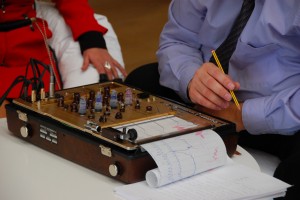Do You Have What It Takes to Be a Polygraph Examiner?

By Codi Peterson, Marketing —
When you think of spy movies, you probably think of witty banter, fast cars, and evil organizations. Even polygraph tests are sort of iconic in spy thrillers. However, the polygraph exams conducted in movies are rarely accurate. Real polygraph tests are designed to measure key physiological indicators such as blood pressure, heart rate, sweat levels, and respiration while the subject is asked a series of questions. It’s much less dramatic than portrayed. However, the importance of this testing is still real.
The CIA and other government agencies use lie detection methods to help them in their investigation and employment processes. To become a polygraph examiner, there are certain steps you have to take in gaining education and skills to be qualified to administer tests. Each of the examiners goes through years of training in order to be able to accurately interpret the results they’ll test for.
Prerequisites
The prerequisites for being a CIA polygraph examiner include the following:
- The candidate must have a bachelor’s degree with a minimum 3.0 GPA.
- The candidate must be prepared to make a 5-year commitment to the agency.
- The candidate must be certified by the American Polygraph Academy. (This certification requires that the candidate complete over 400 hours of in-residence study in under 17 weeks.)
During the course of the program, the candidate will learn the history of lie detection, psychology, ethics, how to operate the polygraph instruments, how to interpret the results, how to formulate the questions, and the legal aspects of administering polygraph exams. Following the receipt of certification from the APA, the candidate must then complete the federal polygraph examiner certification training program. The candidates will be subjected to aptitude tests, personality tests, medical exams, and, in the end, they will also be subjected to a polygraph test.
Upon completion of the program, the candidate is qualified to be a CIA polygraph examiner. As a polygraph examiner they will administer polygraph exams, coordinate with interrogators and other agents, participate as part of a team of agents, provide testimony in courts, and create reports based off of the results of the tests. Many of the people that they examine will be from varying cultures and languages.
Despite the countless hours and energy devoted to becoming a polygraph examiner, there are limits to mew examiners’ abilities. Polygraph tests aren’t 100 percent accurate. That being so, they are not accepted in court as reliable sources of evidence. In addition, each test takes an average of 2–3 hours to administer. This severely limits the amount of tests that polygraph examiners can administer per day. This also contributes to the high prices of polygraph tests.
The Eye Don’t Lie
Efforts have gone in to creating an accurate, computerized technology that only takes thirty minutes to administer. Utilizing an infrared eye sensor and a patented algorithm, Converus developed a method of lie detection alongside a team of well-known scientists that can be used in conjunction with polygraph examination. EyeDetect is a non-intrusive eye lie detection technology that polygraph examiners around the world are beginning to recognize as a tool to use in their investigative processes.
Source
Photo courtesy of Gabriel Rodríguez.

